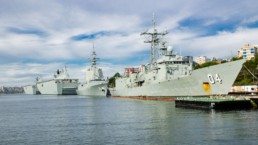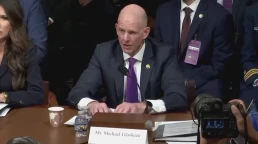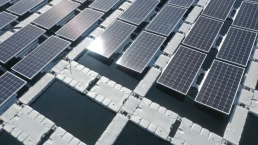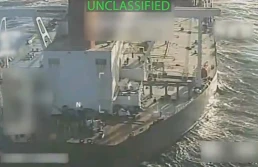The public has not been told that these US military facilities have made Western Australian locations targets for attack in the event of a war.
By Bevan Ramsden, Green Left
Australian governments are allowing Western Australia to become a vital part of the United States war-fighting base and, therefore, an inevitable target for retaliatory strikes in a US war on China.
Much of the militarisation has been carried out in secrecy, meaning the public know little about this US military build-up and its serious implications.

WA first became host to a vital US war fighting facility on September 16, 1967, when a submarine communications radio station, the US Naval Communication Station North-West Cape, was declared open.
The US paid a peppercorn rent, but the structure was designed, built and paid for it. A year later, it was renamed as the Naval Communication Station Harold E Holt, after a former Australian Liberal PM.
The joint naval communication station, located on the north-west coast, six kilometres north of the town of Exmouth, is operated and maintained by the Department of Defence and the US.
The huge radio antenna covers many hectares. With a centre mast of 387-metres, for many years it was the highest human-made structure in the Southern hemisphere.
The antenna is driven by the most powerful radio transmitter in the Southern hemisphere. One million watts of very low frequency (VLF) power enables radio waves to penetrate sea water and communicate with US nuclear-powered and -armed submarines while submerged in the Indian Ocean and Western Pacific.
In a war, the US command to launch nuclear-armed missiles can be sent to their US nuclear submarines from this radio facility on the tip of the Exmouth Peninsula.
In the shadow of the huge antenna, the US has now established the Space Surveillance Telescope (SST) after having shifted this 232 tonne piece of equipment, according to Andrew Fowler’s book Nuked, from White Sands Missile Range in New Mexico (famous as the site of the Trinity atomic bomb test in 1945) to the far west coast of Australia.
The SST is the world’s largest parabolic mirror, enabling the scanning and photographing of satellite orbits.
It is owned and operated by the US Space and Missile Systems Office (USSF) and provides information, according to the Pentagon, for the USSF to be “combat ready” to “fight to protect and defend the US and its Allies from attack in, through and from space”.
According to Fowler “the main function of the SST is to identify and pre-emptively target a space adversary, even if they are not attacking and knock them out, giving the United States superiority in any confrontation”.
Another US installation at North-West Cape, close to the SST, is a giant radar. It has been shipped in, according to Fowler, by the US from the Caribbean to track low orbiting satellites and missile launches.
“Together”, writes Fowler, “the SST and the radar are a formidable duo supporting US military war-fighting capabilities.
“The radar and the high quality telescope integrate Australia further into the US military in a particularly dangerous area: where America and China are facing off in space. It is where a nuclear war could start.”
The WA city of Geraldton, 419 kilometres north of Boorloo/Perth, now features in the US military build-up because it hosts the Kojarena Satellite Communications facility.
While described as an “Australian Defence Satellite Communications Station”, Kojarena was built and paid for by the US, and provides advanced communications for the United States and Australian military.
An Australian Defence Force spokesperson has confirmed that the new facility, which will be named the Combined Communications Gateway Geraldton, will offer real-time operational and logistical information essential for command and control of deployed forces, which would include US and Australian forces in a war against China.
Further north, south east of Derby and 170 kilometres east of Broome, the Curtin RAAF Base is receiving upgrades and extensions, to enable the servicing of US and Australian fighter jets and bombers.
Together with similar upgrading of RAAF Scherger in North Queensland, the two provide back-up airfields should RAAF Tindal be taken out by an enemy missile.
RAAF Tindal is now home to US B52, nuclear-capable bombers, which can fly to China and back without re-fuelling.
Much closer to Boorloo/Perth is the HMAS Stirling naval base on Garden Island, off the coast of Rockingham. This is currently being given an $8 billion upgrade, part of the huge outlay arising from the bipartisan support for AUKUS.
AUKUS will enable the porting, maintenance and re-suppling of US and British nuclear submarines and disposal of their low-level nuclear waste.
NSW Greens Senator David Shoebridge warns that intermediate-level nuclear waste would also be allowed, under a bill before Parliament.
The Australian Naval Nuclear Power Safety Bill, 2023 declares a “nuclear zone” around Garden Island. The Australian Radiation Protection and Nuclear Safety Authority (ARPANSA) has evaluated the dangers of possible nuclear radiation leaks, or accidents, associated with visiting nuclear submarines.
Workers and the local community living or working there have not been advised that they may be forced to evacuate to decontamination centres in the event of accidents or leaks from the nuclear reactors propelling these submarines.
ARPANSA has warned that a catastrophic accident could have serious long-term health effects.
Since the US has a policy to neither confirm or deny if its nuclear submarines are carrying nuclear missiles and because Canberra respects this, it is likely that, in a war situation, US nuclear submarines porting at HMAS Stirling could be carrying nuclear weapons.
The public has not been told that these US military facilities have made Western Australian locations targets for attack in the event of a war.
These important topics and developing strategies to keep Australia out of foreign wars will being discussed at the Independent and Peaceful Australia Network national conference over October 4-6 in Boorloo/Perth.
“Sleepwalking into War?” will feature speakers including former WA Premier Dr Carmen Lawrence, Senator Fatima Payman, Emeritas Professor Ian Lowe AO, Professor Richard Tanter, former Ambassador John Lander and Greens Senators David Shoebridge and Jordan Steele-John.
Bevan Ramsden is a TAFE teacher and a member of the NSW Teachers Federation. He is the editor of the Independent and Peaceful Australia Network IPAN’s monthly e-publication, Voice. Click here for details and registration for IPAN’s conference.
Recent Posts
‘Total Amateur Hour’: FBI Official Says Antifa Is #1 Threat in US—But Can’t Say Where, Who, or What It Is
December 13, 2025
Take Action Now “Just a complete admission here that the entire ‘antifa’ threat narrative is totally manufactured by this administration,” said one…
Utah Leaders Are Hindering Efforts To Develop Solar Despite A Goal To Double The State’s Energy Supply
December 12, 2025
Take Action Now Utah Governor Spencer Cox signed bills that will make it more difficult and expensive to develop and produce solar energy, ending tax…
Report of the Independent Democratic Task Force on U.S. Policy Toward Israel
December 12, 2025
Take Action Now For release in connection with the winter meeting of the Democratic National Committee convening on December 11, 2025 in Los Angeles……
U.S. Realizes It Can Seize Boats After All
December 11, 2025
Take Action Now After months of extrajudicial killings in the waters off Venezuela, the Trump administration opted instead to capture an oil tanker.……




